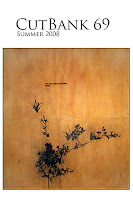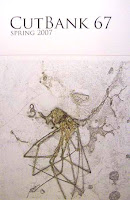
Counterpath Press, 2007
Reviewed by John Findura
It used to be that books of contemporary poetry could often be looked at as either a collection of individual poems or the occasional group of poems loosely connected by some narrative or stylistic thread. More recently however, the “project” book has very much come into vogue. The “project” book can be seen as a kind of novella in verse, or, at the very least, a heavily connected collection of individual poems that work better as a whole than individually. Starting with his last book, the excellent and daring Quarantine, Brian Henry seems to have grasped firmly onto this idea that the whole may be greater than the sum of its parts.
The Stripping Point is composed of two poetic series, the first titled “More Dangerous Than Dying” and the second, “The Stripping Point.” Eschewing individual titles, we are forced to contemplate the book as a whole as it cannot readily be broken down into bite-size pieces, much like the way the individual songs of a concept album lose their magic once separated into radio-friendly singles. The only guideposts along the way are quotations that precede each part and are thankfully referenced in a “Source” section.
The idea of a dual series worked well for Henry in Quarantine, but in comparing that work to The Stripping Point, the newer work appears to succeed, albeit to a lesser degree. The first sequence is composed of 31 poems set in a 1990s paper mill chronicling “the vicissitudes of a relationship that is simultaneously new and at its depleted end,” according to the jacket copy. While that may sound like a very simplified breakdown of a million things, from Malcolm Lowry’s Under The Volcano to Casablanca, in actuality it reads more like a disturbingly unfunny episode of The Office:
A thing is delivered
to your In-basket
carbon-copy to me
(…)
We hold hands
by the water cooler
It is this everyday language and action that ultimately grabs the reader’s attention. “The office party was a carnal affair” comes later, to the surprise of no one. The reality of the words manage to both shock in their utter frankness and to cause wonder that a poem can be constructed of the everyday, much like the disbelief that accompanies the realization that a particular sculpture was once a cast-off piece of stone.
The significance of the difference
between the tip as calculated
and the tip as left on the table
becomes a wedge between us
Somehow, the mundane has infiltrated the hallowed halls of contemporary verse. But it is not just the words; it is also the distance of Henry himself from the poems. Using a style that he began with Quarantine, Henry has left almost all traces of the poet absent from the poems. Unlike his earlier collections Astronaut and Graft, The Stripping Point feels as though it were created in a vacuum, much like the modern workplace feels.
Blond hair on your overcoat
The situation revolves on itself
Stasis action guilt
It’s the first that hurts
the last that reminds us
we’re here
At times Henry sounds like he is reciting his own version of Nostradamus:
Across the table
fallacious conclusions and unencumbered assumptions
mark their method of attack
It all ends up at the landfill
(…)
The plant reshifts priorities
returns to shredding trees
In hindsight, the only possibly thing was indeed for the plant to return to shredding the trees. The plant will continue its pulping of trees far longer than the relationship between co-workers can ever last.
The second, much more experimental, series of poems, titled “The Stripping Point,” runs to fifty-five sections. As it runs its course, it literally is “stripped away,” from 6 lines to only two. Beginning “Decide on deciduous or remain ever green / My love for envy is not your color”, “The Stripping Point” runs down like the ticking of the doomsday clock. The repetition of certain lines keeps the momentum running forward to the inevitable ending of “Surrender to dim and be done with darkness”.
The key to this entire section of the book is that inevitability, along with lines such as “Some days the tongue needs a prophylactic” and “Delicious and made with desire from desire”. Perhaps the only negative is the overuse of words such as “nival” and “riparian.” Fine words though they may be, the echoing of the words causes them to lose some of their meaning and their uniqueness as the poem clicks to its end.
What impresses the most is the fact that Henry is still experimenting and growing and there is a genuine excitement preceding each new book. As he has proven so far, there is little in language or subject matter that cannot find its way into the poetic idiom. The monotonous existence that many of us find ourselves is a theme for many poets, yet few take it to its place in the real world. A part of all of us, unfortunately, understands
We strive for the effluvium
but lack all requisite lightness
find ourselves squarely placed
in the fluorescence of the feebly salaried
**
Brian Henry is the author of four previous books of poetry: Astronaut (2000), American Incident (2002), Graft (2003), and Quarantine (2006). His poems have appeared in many magazines around the world, including Jacket, New American Writing, American Poetry Review, Boston Review, and Volt. He has co-edited Verse since 1995, and he co-edited The Verse Book of Interviews (2005). He currently teaches literature and creative writing at the University of Richmond in Virginia.
**
John Findura holds an MFA from The New School. His poetry and criticism appear in journals such as Mid-American Review, Verse, Fugue, Fourteen Hills, Rain Taxi, GlitterPony and H_NGM_N, among others. Born in Paterson, he lives and teaches in Northern New Jersey.




